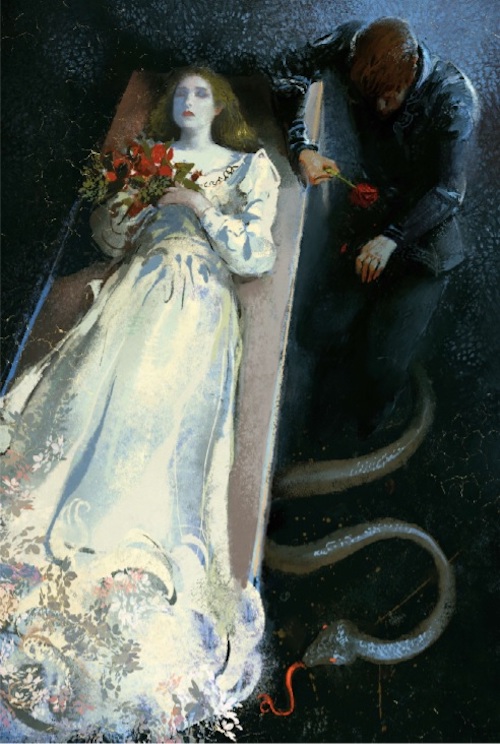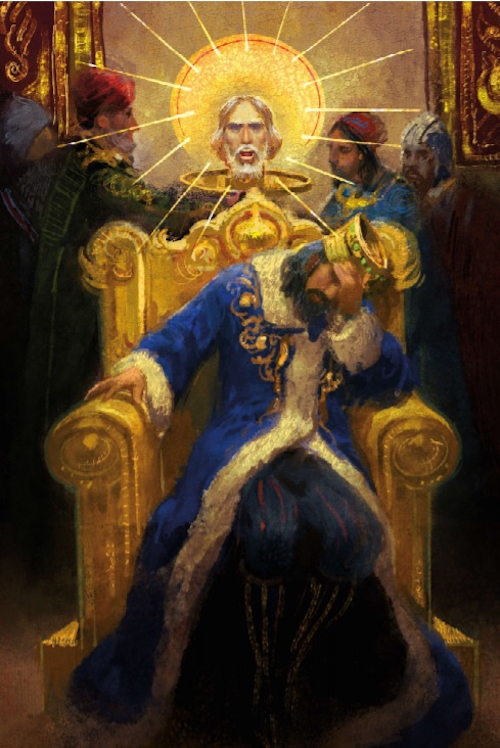Dive into the epic world of Leigh Bardugo’s Grishaverse series with a beautifully illustrated replica of The Lives of Saints—the Istorii Sankt’ya—featuring tales of saints drawn from the beloved novels and beyond. These tales include miracles and martyrdoms from familiar saints like Sankta Lizabeta of the Roses and Sankt Ilya in Chains, to the strange and obscure stories of Sankta Ursula, Sankta Maradi, and the Starless Saint.
We’re excited to share an excerpt below, along with stunning illustrations by Daniel J. Zollinger. The Lives of Saints publishes October 6th with Imprint.
Sankt Valentin

Just days before her wedding was to take place, a young bride fell ill, and though she fought valiantly and was tended to with love and care and many prayers, she perished. These were the worst days of winter, and because the ground was too cold to give way to shovels or picks, no proper grave could be dug. The girl’s family was too poor to afford a mausoleum. So they dressed the girl in the silks that would have been her bridal gown and laid her down upon a slab in the icehouse, her hands folded over her breast, her fingers clutching a bouquet of leaves and winter berries. Each day, her family would sit awhile and visit with her, and the young man who should have been her groom came to weep over the body long into the night.
When the first thaw arrived, a grave was dug on hallowed ground and the girl was lowered into it, a plain headstone marking her place of rest.
But the next morning, when the girl’s mother went to visit her daughter’s grave, she found a snake curled upon the headstone, its scales gleaming black in the sun. The woman stood shaking, fresh flowers in her hands, too afraid to approach, until finally, tears on her cheeks, she gave up and returned home.
All spring, the grieving woman would visit the cemetery with a new bouquet in hand. The snake would lift its flat head at her approach and sometimes slither down the stone to the gently mounded dirt. But it never left the girl’s grave and so no one could come to pay their respects—not her mother, not her father, not the heartbroken young man who had loved her.
The woman went to the church and prayed to Sankt Valentin, the patron saint of snake charmers and the lonely, and that night, Sankt Valentin spoke to her.
“Go to the grave,” he said, “lie down on the ground beside the snake, and all will be revealed to you.”
The woman trembled. “I cannot!” she pleaded. “I am too afraid.”
But Sankt Valentin’s voice was steady. “You can choose faith or you can choose fear. But only one will bring what you long for.”
So the next day, the woman walked to the cemetery, and when she saw the snake lying in the new green grass that had sprung up over her daughter’s grave, she didn’t turn away, but still shaking, made herself lie down on the damp earth. The serpent lifted its head, its glittering eyes like mourning beads. Certain it was about to strike, the woman prepared to feel the snake’s bite and join her daughter in the next life.
But instead, the serpent spoke, its slender tongue tasting the air.
“Mama,” it said, “it is I, the spirit of your lost daughter, returned to tell you of my plight. I did not die of natural illness, but from poison, fed to me in what was meant to be medicine by the man who swore he loved me until I told him I did not love him any longer and did not wish to be his bride. He laughed over my corpse in the icehouse, and now he is afraid to visit this grave, for he knows the Saints will not allow a murderer to feign honest prayer on hallowed ground.”
The woman wept, and let the snake curl gently around her wrist, and told her daughter she loved her. Then she marched down to the town and found the man who had claimed to love her daughter.
“You must go with me to the cemetery,” she said, “and pay your final respects to my daughter, who would have been your bride and whom you swore to love.”
The young man protested. Hadn’t he already visited her countless nights in the cold of the icehouse? And wasn’t there a snake said to be lurking around the headstones?
“What righteous man fears a snake?” she demanded. “What man professes love, then will not speak his prayers on hallowed ground?”
The townspeople agreed and wondered why the young man resisted. At last, he submitted and followed her to the cemetery. When his footsteps slowed, she seized his hand and dragged him along the path. They passed through the gates and on to the girl’s grave, where the snake lay curled upon it.
“Go on,” said the woman. “Kneel and speak your prayers.”
As soon as the young man opened his mouth, the snake uncoiled and sprang up, biting him right on the tongue. He died with the black tongue of a murderer, and was buried in unconsecrated ground, and was mourned by no one.
The snake was never seen again, but a quince tree grew beside the young bride’s grave and lovers often met beneath its branches, when the weather was warm enough.
It is customary for the mothers of brides to offer prayers to Sankt Valentin, and seeing a snake on your wedding day is known to be good luck.
Sankt Lukin
The Logical

Once there was a prince who desperately wanted to be a king. He had among his councilors a wise man named Lukin, who could always be counted upon for sage advice and plenty of it. There were those who said that Lukin talked too much, others who likened him to a prattling bird, and still others who were known to discreetly place cotton in their ears when Lukin cleared his throat to speak.
While it was true Lukin’s speeches were so long that young men grew beards and wheat came to harvest in the time it took him to reach his point, that point was most often sound. He predicted how many soldiers a rival prince would have waiting and when he meant to attack; he foresaw a year of drought and wisely admonished the prince to set aside stores of water; he guided the prince to prudent investment in merchant expeditions that brought back chests full of jewels and gold.
Once, when a neighboring army was threatening to invade, the prince sent Lukin to negotiate with them. When it came time for Lukin to plead his case, he spoke—and kept speaking, one argument leading to the next and then the next, in an endless tide of words. Soon the general nodded off and then his colonels, and then the sergeants and so on, until every last member of the invading army had been bored first to sleep and then to death.
The prince rewarded Lukin’s bloodless victory and continued to heed his advice. In time, just as the prince had dreamed, and Lukin had predicted, he became king.
With Lukin’s help the new king ruled successfully, expanding his territory and his power. But life was not without its troubles. The king’s first wife vanished in the night with a swineherd, leaving nothing but a note behind confessing that she would rather tend pigs if wearing a crown meant listening to Lukin talk. His second wife joined a troupe of traveling circus performers. His third wife ate a bad oyster and died, but no one was certain if it was truly an accident. Each of these women gave the king a son.
As the king grew older, he worried that his death would bring chaos for the kingdom if each of his sons vied for the throne. He knew he had to choose an heir, so as he always did, he went to Lukin for advice.
After many hours of holding forth on the various factors and possible outcomes each choice might imply, Lukin did something he rarely did—he paused.
This resulted in the king doing something he’d never had reason to do before—he urged Lukin to go on.
Lukin confessed that the king had sired three fools, each son more incautious and venal than the last. None of them were fit to rule and all would bring great misery to the land.
“Well,” said the king, “if you cannot tell me who will make the best king, perhaps you can tell me who would make the least terrible king.”
After much debate, during which the moon rose and fell and rose again, Lukin pronounced that the second son might possibly—under the proper conditions, with all due allowances for temperament, and given appropriate and judicious counsel—make the least disastrous ruler.
The king called the court together, and before all his retainers, he decreed that upon his death, the throne would pass to his second son—on one condition. His son must vow to keep Lukin, the king’s oldest, wisest adviser, beside him, to offer sage counsel until the end of Lukin’s days. Before all the court, the second son gave his word, and a few years later, when his father passed, he was crowned with all due ceremony.
His first act as king was to call for Lukin’s execution. As eager as many of the old king’s retainers were for a bit of respite from Lukin’s tongue, they had heard the second son give his solemn word. Such a vow could not be broken.
“Ah,” said the second son, “but all I promised was to keep Lukin as my adviser until the end of his days. That end will simply come sooner than predicted.”
The courtiers agreed that this did meet the letter of the vow, and some even marveled at the new king’s cleverness. Perhaps he wouldn’t need an adviser after all.
Lukin was marched to the executioner’s block and went to his knees with prayers on his lips, for even in these moments before his own death, he had no use for silence. The executioner raised his axe and with a single clean slice cut Lukin’s head from his body. There was a thunk as it landed and rolled onto its side, and though the gathered courtiers knew they must not cheer a wise man’s death, they did heave a great sigh at the sudden, glorious quiet, broken by no dire predictions of disasters to come, nor instructions for the best way to prepare venison, nor disquisitions on the great earthquake of Vandelor.
A bird chirped outside the window. In some distant corner of the castle, a woman laughed. The young king smiled.
Then a voice broke the silence.
Lukin’s head lay in the dust, but his eyes were still open and his lips had begun to move again. Having one’s head removed from one’s body was a most novel experience and brought to mind a great many lessons, which he was most delighted to share.
The second son was forced to honor his vow or lose his crown. Lukin’s head was placed upon a golden platter, and from it, he dispensed advice to the new king for the entirety of his rule, which was long, just, and miserable.
Sankt Lukin is the patron saint of politicians.
Excerpted from The Lives of Saints, copyright © 2020 by Leigh Bardugo.










